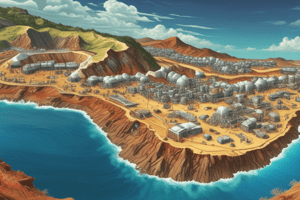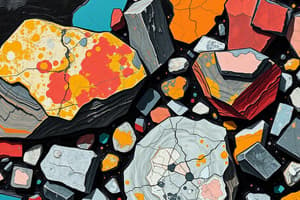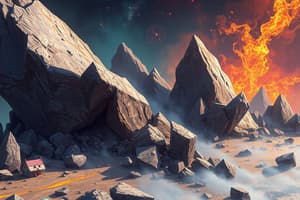Podcast
Questions and Answers
أي من الموارد المعدنية التالية يعتبر من المعادن الأساسية للتنقيب عنه؟
أي من الموارد المعدنية التالية يعتبر من المعادن الأساسية للتنقيب عنه؟
- الإسمنت
- الزجاج
- الحديد (correct)
- السليكون
ما هو أحد الموارد المعدنية الذي له قيمة اقتصادية عالية ويستخدم في صناعة المجوهرات؟
ما هو أحد الموارد المعدنية الذي له قيمة اقتصادية عالية ويستخدم في صناعة المجوهرات؟
- الفوسفات
- الذهب (correct)
- الرمل
- الكلنكر
أي من الخيارات التالية ليس مادة معدنية يتم التنقيب عنها عادةً؟
أي من الخيارات التالية ليس مادة معدنية يتم التنقيب عنها عادةً؟
- الفضة
- الرصاص
- الألمنيوم
- الماء (correct)
ما هو العنصر المعدني الذي يتم استخدامه بشكل واسع في صناعة الأسلاك الكهربائية؟
ما هو العنصر المعدني الذي يتم استخدامه بشكل واسع في صناعة الأسلاك الكهربائية؟
أي من المعادن التالية يعتبر من المعادن الثقيلة التي يتم التنقيب عنها؟
أي من المعادن التالية يعتبر من المعادن الثقيلة التي يتم التنقيب عنها؟
ما هي الأسباب المحتملة لحدوث الكوارث الطبيعية؟
ما هي الأسباب المحتملة لحدوث الكوارث الطبيعية؟
أي من الفروع التالية يركز على تبلور المعادن؟
أي من الفروع التالية يركز على تبلور المعادن؟
ما الذي يهدف إليه تحديد الحواجز الطبيعية في السياقات العسكرية؟
ما الذي يهدف إليه تحديد الحواجز الطبيعية في السياقات العسكرية؟
ما هي فوائد معرفة خصائص المعادن في علم المعادن؟
ما هي فوائد معرفة خصائص المعادن في علم المعادن؟
أي من الآتي يعد من آثار الكوارث الطبيعية على المباني؟
أي من الآتي يعد من آثار الكوارث الطبيعية على المباني؟
ما هو العلم الذي يتعامل مع دراسة شكل الأرض؟
ما هو العلم الذي يتعامل مع دراسة شكل الأرض؟
أي من الفروع التالية يرتبط بشكل مباشر بإدارة البيانات من القياسات الأرضية؟
أي من الفروع التالية يرتبط بشكل مباشر بإدارة البيانات من القياسات الأرضية؟
ما هو الهدف الرئيسي من علم المسح الجيولوجي؟
ما هو الهدف الرئيسي من علم المسح الجيولوجي؟
أي من التخصصات التالية يتطلب استخدام تكنولوجيا متقدمة لجمع البيانات عن الأرض؟
أي من التخصصات التالية يتطلب استخدام تكنولوجيا متقدمة لجمع البيانات عن الأرض؟
ما هي إحدى الفوائد الأساسية لعلم السمات البصرية في علم الاستشعار عن بعد؟
ما هي إحدى الفوائد الأساسية لعلم السمات البصرية في علم الاستشعار عن بعد؟
Flashcards
الاستشعار عن بعد
الاستشعار عن بعد
طريقة جمع المعلومات عن سطح الأرض من مسافات بعيدة باستخدام الأجهزة
علم الزلازل
علم الزلازل
دراسة الزلازل و الموجات الزلزالية
علم شكل الأرض
علم شكل الأرض
دراسة أشكال سطح الأرض.
مسوحات تصویریة
مسوحات تصویریة
Signup and view all the flashcards
مسوحات جيولوجية
مسوحات جيولوجية
Signup and view all the flashcards
مواقع السدود
مواقع السدود
Signup and view all the flashcards
الموارد المعدنية الطبيعية
الموارد المعدنية الطبيعية
Signup and view all the flashcards
الذهب
الذهب
Signup and view all the flashcards
الفوسفات
الفوسفات
Signup and view all the flashcards
التنقيب عن المواد
التنقيب عن المواد
Signup and view all the flashcards
علم البلورات
علم البلورات
Signup and view all the flashcards
علم المعادن
علم المعادن
Signup and view all the flashcards
كوارث طبيعية
كوارث طبيعية
Signup and view all the flashcards
الحواجز الطبيعية
الحواجز الطبيعية
Signup and view all the flashcards
مصادر المياه الجوفية
مصادر المياه الجوفية
Signup and view all the flashcards
Study Notes
Minerals and Rocks
- Geology is the study of the Earth and its coverings, focusing on composition, factors affecting them, and their history.
- Studying Earth is important for:
- Locating energy sources (oil, gas, minerals).
- Determining suitable construction sites (dams, bridges).
- Prospecting for resources (gold, silver, copper, lead, iron, aluminum, nickel, phosphate, halite).
- Finding construction materials (sand, gravel, limestone, marble).
- Identifying chemical resources (sulfur, calcium, sodium, chlorine) for drugs, pesticides, and fertilizers.
- Locating water resources, especially in arid/desert regions.
- Understanding natural disasters (volcanoes, earthquakes, floods).
- Identifying natural barriers and suitable military sites.
Branches of Geology
- Crystallography: Studying mineral crystallization based on composition, chemical and physical characteristics, and conditions of existence.
- Mineralogy: Studying minerals through their physical and chemical properties, classification, and conditions of existence.
- Petrology: Examining rock types, studying their origin, composition, characteristics, classification, and conditions of existence.
- Dynamic Geology (Physical): Focusing on internal/external factors affecting natural phenomena (mountains, rocks, minerals).
- Paleontology: Studying fossils and remnants of ancient organisms and plants from previous geological eras.
- Historical Geology: Investigating the order and sequence of rock layers from ancient times to the present, including fossil characteristics, and geological time scales.
- Stratigraphy: Studying sedimentary rock layers, their formation conditions, and places of deposition.
- Structural Geology: Exploring the development and evolution of Earth's crust throughout geological ages, including the causes behind features like faults, fractures, and mountain formation.
- Geophysics: Focusing on the study of the Earth's interior, including geological formations and deposits like oil and minerals.
- Geochemistry: Studying minerals and rocks using chemical methods, analyzing the distribution of elements in Earth's crust, and determining the type and proportion of mineral ores.
- Economic Geology: An applied science focused on finding and evaluating economic resources. This includes branches like petroleum geology, mining geology, engineering geology, and the study of mineral and radioactive isotopes deposits.
- Hydrogeology: Studying sources of surface and groundwater, including physical and chemical properties, and the layers of earth containing groundwater.
- Engineering Geology: Understanding the mechanical and engineering properties of Earth's crust to support construction projects, such as bridges, dams, buildings, etc.
What is a mineral?
- A mineral is a naturally occurring, homogeneous, inorganic solid with a crystalline structure and a fixed or (uniformly variable) chemical composition.
- There are over 2000 known minerals on Earth, with new ones discovered approximately every year.
What do all minerals have in common?
- Natural Formation: Created through natural processes.
- Inorganic: Never alive.
- Solid State: Fixed volume and shape.
- Unique Chemical Composition: Compound of one or more elements.
- Definite Crystal Structure: Atoms arranged in an orderly, repeating pattern.
Physical Properties of Minerals
- Color: Can be diagnostic, but not always reliable due to impurities.
- Streak: The color of the mineral's powder form. More reliable for identification.
- Luster: The way a mineral reflects light from its surface. This can be metallic (like a metal), or non-metallic (dull, pearly, silky, glassy, vitreous(glassy), or earthy).
- Transparency/Translucency/Opaqueness: The ability of light to pass through the mineral.
- Hardness: Resistance to scratching.
- Cleavage/Fracture: The way a mineral breaks. Cleavage is along specific planes; fracture is irregular.
- Specific Gravity: Density relative to water, used for identification.
- Other properties such as Fluorescence and Phosphorescence.
The Structure of Minerals
- The atoms of minerals arranged in an orderly pattern to form a crystal structure.
Relationships Among Sciences
- Geology is interconnected with other sciences (chemistry, physics, biology, etc).
- This interaction is apparent in the different sub-branches of geology. For example, mineralogy uses chemistry to define mineral composition and properties.
Studying That Suits You
Use AI to generate personalized quizzes and flashcards to suit your learning preferences.




